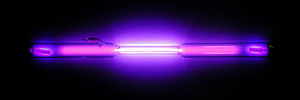Nitrogen
 Nitrogen discharge tube. | |||||
| General properties | |||||
|---|---|---|---|---|---|
| Name, symbol | Nitrogen, N | ||||
| Alternative name | Azote | ||||
| Appearance | Colorless gas, liquid or solid | ||||
| Nitrogen in the periodic table | |||||
| |||||
| Atomic number | 7 | ||||
| Standard atomic weight (Ar) | 14.007 | ||||
| Group, block | (pnictogens); p-block | ||||
| Period | period 2 | ||||
| Electron configuration | [He] 2s2 2p3 | ||||
per shell | 2, 5 | ||||
| Physical properties | |||||
| Colorless | |||||
| Phase | Gas | ||||
| Melting point | 63.15 K (−210.0 °C, −346.0 °F) | ||||
| Boiling point | 77.355 K (−195.795 °C, −320.431 °F) | ||||
| Density at (0 °C and 101.325 kPa) | 1.251 g/L | ||||
| when liquid, at | 0.808 g/cm3 | ||||
| Triple point | 63.151 K, 12.52 kPa | ||||
| Critical point | 126.192 K, 3.3958 MPa | ||||
| Heat of fusion | 0.72 kJ/mol | ||||
| Heat of | 5.56 kJ/mol | ||||
| Molar heat capacity | 29.124 J/(mol·K) | ||||
| pressure | |||||
| Atomic properties | |||||
| Oxidation states | 5, 4, 3, 2, 1, −1, −2, −3 (a strongly acidic oxide) | ||||
| Electronegativity | Pauling scale: 3.04 | ||||
| energies |
1st: 1402.3 kJ/mol 2nd: 2856.0 kJ/mol 3rd: 4578.1 kJ/mol | ||||
| Covalent radius | 71±1 pm | ||||
| Van der Waals radius | 155 pm | ||||
| Miscellanea | |||||
| Crystal structure | Hexagonal | ||||
| Speed of sound | 353 m/s (gas, at 27 °C) | ||||
| Thermal conductivity | 25.83×10−3 W/(m·K) | ||||
| Magnetic ordering | Diamagnetic | ||||
| CAS Registry Number |
17778-88-0 7727-37-9 (N2) | ||||
| History | |||||
| Discovery | Daniel Rutherford (1772) | ||||
| Named by | Jean-Antoine Chaptal (1790) | ||||
Nitrogen is a chemical element with symbol N and atomic number 7. Nitrogen is a common element in the universe, estimated at about seventh in total abundance in our galaxy and the Solar System. On Earth, the element is primarily found as the gas molecule; it forms about 78% of Earth's atmosphere. The element nitrogen was discovered as a separable component of air, by Scottish physician Daniel Rutherford, in 1772.
Contents
Properties
Chemical
Nitrogen is a nonmetal, with an electronegativity of 3.04. It has five electrons in its outer shell and is, therefore, trivalent in most compounds. The triple bond in molecular nitrogen (N2) is one of the strongest. The resulting difficulty of converting nitrogen into other compounds, and the ease (and associated high energy release) of converting nitrogen compounds into elemental N2, have dominated the role of nitrogen in both nature and human economic activities.
While nitrogen is relative inert, certain metals such as magnesium or lithium will burn in a nitrogen atmosphere.
Physical
At room temperature, nitrogen is a colorless and odorless gas. At atmospheric pressure, molecular nitrogen condenses (liquefies) at 77 K (−195.79 °C) and freezes at 63 K (−210.01 °C) into the beta hexagonal close-packed crystal allotropic form. Below 35.4 K (−237.6 °C) nitrogen assumes the cubic crystal allotropic form (called the alpha phase). Liquid nitrogen, a fluid resembling water in appearance, but with 80.8% of the density (the density of liquid nitrogen at its boiling point is 0.808 g/mL), is a common cryogen.
Availability
Nitrogen cylinders can be bought at hardware stores and welding supply stores. Liquid nitrogen can be bought from chemical suppliers, and while it's not expensive, the container used for storage, Dewar, is.
Preparation
Nitrogen can be isolated from air via reduction of oxygen with copper turning or other reducing agents (except metals that will burn in a nitrogen atmosphere, such as lithium, magnesium or titanium). The purified gas will contain ~1% argon. Smaller, but purer amounts of nitrogen can also be obtained by decomposing sodium azide. Nitrous oxide can also be used.
Liquid nitrogen can be made at home, by employing an air compressor and a cooling installation, though making such an installation requires skill. A good tutorial can be found here.
Projects
- Cooling baths (liquid nitrogen)
- Haber process (small scale)
- Make lithium nitride
- Inert atmosphere
Handling
Safety
Gaseous nitrogen is inert and is non-toxic, but in an enclosed space at high concentrations can displace oxygen, and therefore presents an asphyxiation hazard.
Direct skin contact with liquid nitrogen will cause severe frostbite (cryogenic "burns"), either instantly or a second or more after direct exposure, depending on the form of liquid nitrogen. Normally, small amounts of liquid nitrogen will not cause anything but superficial frost on the surface of the skin if the contact is brief. However, if the liquid nitrogen lingers for too long, the tissue will freeze. It gets worse if a droplet of liquid nitrogen gets between your palm and a hard surface, like when grabbing the dewar handle, as this will instantly give you a frostbit.
Storage
Compressed nitrogen gas cylinders should be stored away from any heat sources. Liquid nitrogen dewars should be kept away from any source of heat and light and MUST have a pressure release valve to prevent a pressure build-up. The valve must be checked from time to time for any defects.
Disposal
Nitrogen can be safely released in atmosphere. Avoid doing this in a closed chamber.